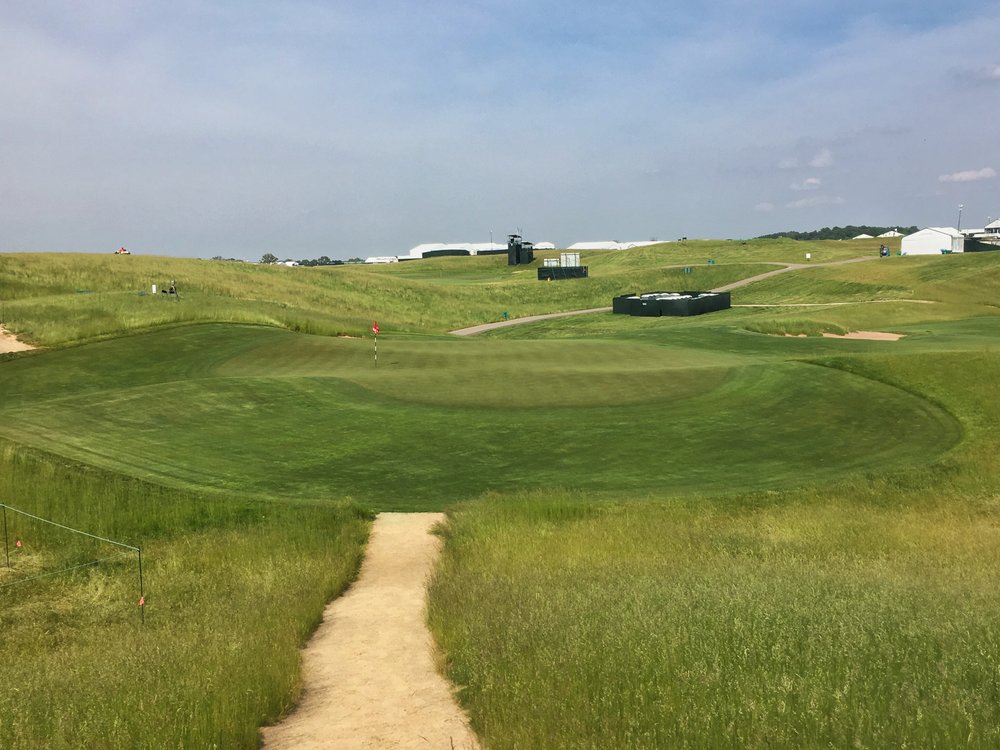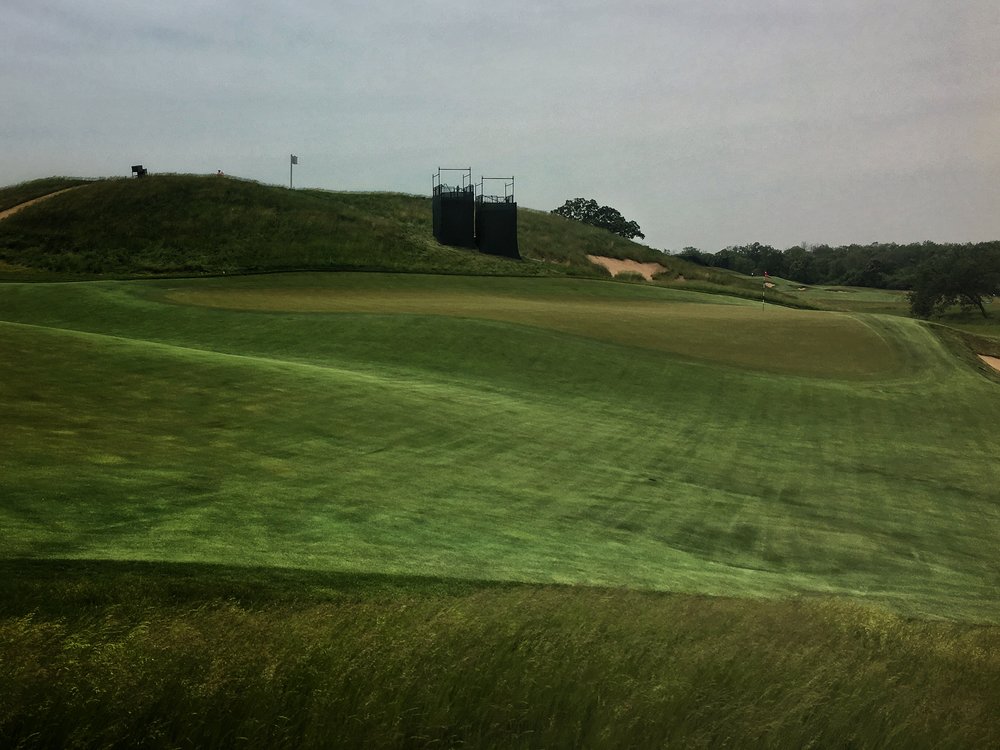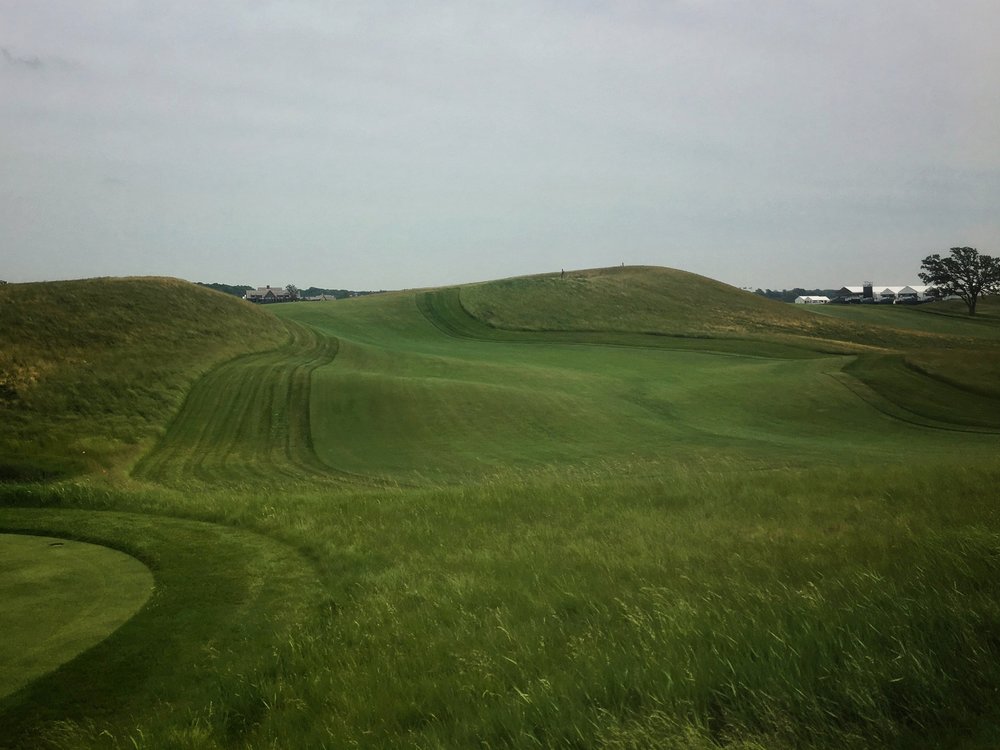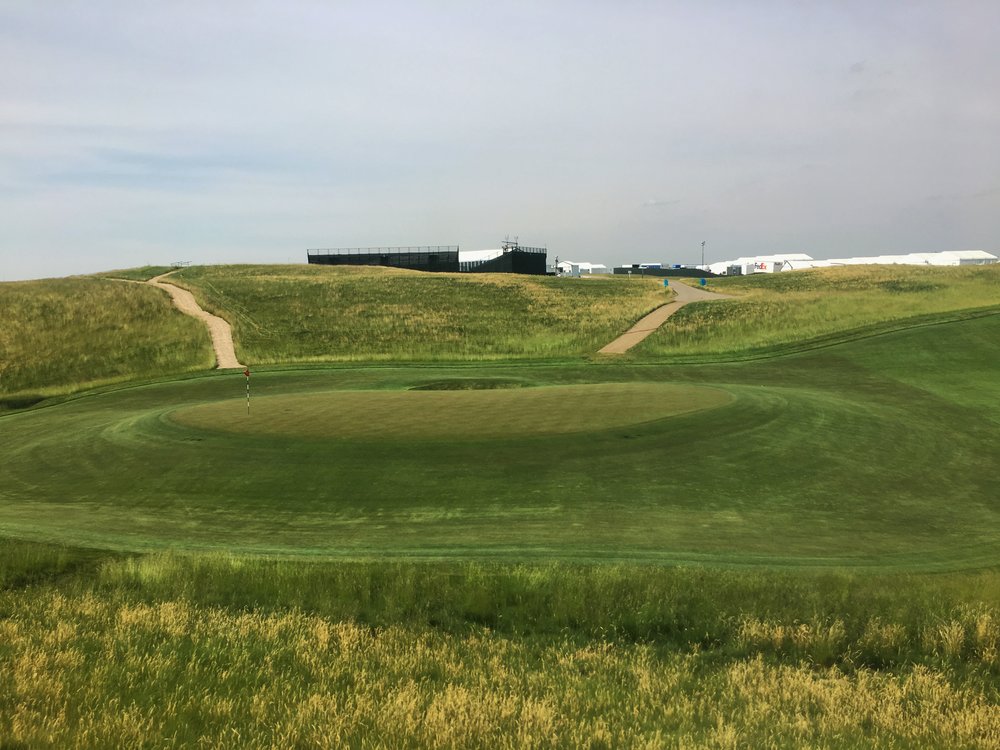The U.S. Open heads to Wisconsin’s Erin Hills this week, the championship’s first trip to the Badger State in 117 playings.

Erin Hills is the brainchild of Bob Lang, designed by Michael Hurdzan, Dana Fry and Ron Whitten. The course is sure to make headlines this week and already has – the story of its creation was beautifully documented in Gary D’Amato’s fantastic 6-part series The Making of Erin Hills and also a well-done truncated version by the Chicago Tribune’s Teddy Greenstein.
I played Erin Hills in 2009 and remember coming away with mixed feelings about the course. A much-younger-me didn’t play well, which definitely altered my perception of the course (NOT GOOD!).
On Sunday, I walked all eighteen holes and observed some of the world’s best players preparing and hitting shots on the course. While Erin Hills doesn’t have the traditional U.S. Open look and feel of an Oakmont, Merion or Shinnecock Hills, it will test every aspect and facet of players’ games.

The third green at Erin Hills
As the week goes on I will dive into specific key holes, but in the meantime, be sure to follow us on Twitter and join our newsletter to ensure you never miss a beat.
Flexibility
Erin Hills has been groomed by the USGA for nearly a decade in preparation for this week’s championship. Much like Chambers Bay, you will see flexibility in its setup through different tee boxes, which will allow the holes to play different yardages and angles, which change the strategy and desired shot shape off the tee. This flexibility is a unique and excellent wrinkle that Erin Hills offers.
Wind direction and strength
The golf course has little to no trees in play and has many exposed areas that will make the wind a huge factor on everything from full shots to putts. The word is that the USGA plans to get the greens rolling around 14 on the stimpmeter, which will make putting extremely difficult if the wind blows. If that is the case, players who can avoid downwind and downhill putts will be well served.
The natural ground movement
One aspect of Erin Hills that won’t transfer well to photos and video is the immense scale and natural land movement that the property possesses. Dr. Hurdzan, Dana Fry and Ron Whitten had a remarkable property to work with and their team wisely moved little dirt in the construction of the course, relying rather on natural movement to create the greensites and strategic interest of holes. Examples of the role that the rolling terrain will play in the championship:

The par-5 14th green funnels shots towards the back right but also repels those too far right
Funneling shots and the ground game – Many of the green surrounds have areas that will funnel shots towards the green or repel them far away. If a player finds trouble off the tee and loses the ability to control the spin of their approach shot, many holes will offer a unique recovery option where players can play a shot short and use the land to run a ball up and still escape with a birdie opportunity.
Missing long – In general, missing long is a very bad idea at Erin Hills. Many of the greens are perched and have steep fall-offs over the green. Shots that carry one or two yards long can end up 30 yards over the green, leaving impossible chip shots. Distance control on iron play will be a key to success.

The rolling 12th fairway is a tough place to get a flat lie
Uneven lies – The fairways at Erin Hills are sculpted from the natural land and will give many players uneven lies. This is one of the great subtle tests that the course will offer, playing into the hands of the best iron players. I would look at who seems to play well at Augusta, Kapalua, Memorial and other second-shot golf courses.
Bunkering – The natural topography yielded beautiful natural bunkers that appear as if they were set in the land forever. Much like the fairways, the bunkers too can yield uneven lies and awkward shots because of the land’s natural movement. I have never seen slope like this in bunkers and it adds an added “hazard” aspect to the bunkering.
“Big but small” ballpark
Don’t judge this book by its cover – while listed at 7,741 yards, Erin Hills plays much shorter than its yardage. The fairways are firm and fast and if they stay that way I think that distance will not be as big a factor as many experts are suggesting. I personally think that driving it straight and having a solid gameplan is far important than being long. That being said, if you can drive it long and straight it’s obviously a big advantage. On many holes, you will see long hitters forced to lay back because of bunkers that shrink their landing area.
The Fescue
The buzz of the tournament is the thick fescue that lines the fairways at Erin Hills. The fescue is thickest right off the fairway, thinning out the further you venture into it and penalizing the average shot more than the horrible shot. Geoff Shackelford speculated that this thickness is caused by overspraying/irrigation, a common problem with maintaining fescue.
I am a believer in championship golf where the further you miss, the greater the penalty should be. This fescue is my one complaint regarding the course. The thicker fescue should exist further from the fairway and be progressive not regressive. With all that said, the fairways have substantial width and players can conceivably hit 14/14 fairways, something that isn’t possible often on U.S. Open courses.
The green complexes
Generally speaking, the green complexes at Erin Hills are massive, allowing officials to dramatically alter a hole’s strategy with different pin positions. These greens are very subtle and reward great shots with good looks and putts that don’t contain a ton of break. Sometimes these subtle nuances can be the most difficult greens to putt. While good shots are rewarded, average ones that leave lengthy putts can be quite difficult and treacherously fast.
Around the green there is an abundance of short grass that will give players all types of shot options. You will see players opting for putts, bump-and-runs and lob shots. The key will be players avoiding short siding themselves and leaving substantial green to work with.

Gameplan
Erin Hills is packed with strategy. Hurdzan, Fry and Whitten entice players with heroic options that carry great risk and reward while also offering a safe option on nearly every hole. I feel that patience and a gameplan that has a selective risk strategy will yield the winner.
As highlighted in the previous sections, my keys for Erin Hills are finding fairways, distance control with irons and avoiding short-siding. As I think about who I like as sleepers and favorites at Erin Hills the more, I side with veterans who are the best iron players.


 by
by 
